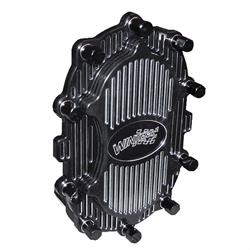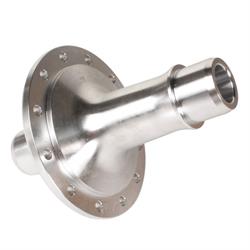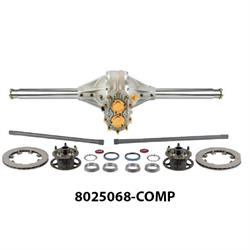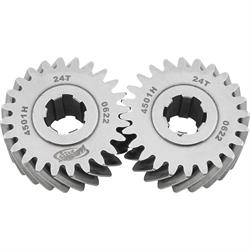What is a Quick Change Rear End and How Does It Work
What is a Quick Change Rear End?
The truth is the basic premise of the quick change is quite simple: insert an extra set of gears in the rear end between the driveshaft and the differential that can easily be changed to adjust the final drive ratio based on the driving conditions. For racers from short track to drag racing and drifting, the extra gears allow you to fine tune drive ratios for the specific track you’re running, maximizing power exactly where and when you need it. For hot rodders, it’s an opportunity to quickly switch from a freeway or daily driving-friendly ratio to a more aggressive one for stoplight-to-stoplight blasts or quarter-mile passes.
Vintage Quick Change Rear End | A Brief History
It would be difficult to nail down exactly when the first quick change was developed. Early units ran the gamut from one-off, homemade pieces to production rears from people like “Cookie” Ledington (Cook’s Machine Works), Ted Halibrand, Pat Warren, and Jim Frankland. Most were based on a cast aluminum or magnesium center section that utilized early Ford carriers and axle housings. There were even some examples that incorporated a change gear housing that was welded directly to the back of a Ford banjo center section.
Early production quick changes were typically available in three different sizes. The smallest was known as a Model A or Midget rear, for Midgets and other lightweight racers; the mid-sized V8 rear was most used in roadsters and other mid-size and weight cars; and the Champ saw use in Sprints and other larger racecars. Today’s quick changes have been developed for far more specific applications, where the center section design is fundamentally different from one type of racecar to another. We’ll discuss those differences in a little more detail later, but first we’ll delve into the basic internal components universal to all quick changes.
The Quick Change Advantage | How Does a Quick-Change Rear End Work?
If you imagine a typical fixed-ratio rear end, such as a 9-inch Ford, the driveshaft hooks to the rear via a splined yoke that couples with the pinion gear. That pinion engages with the ring gear, which is bolted to the differential or spool, and as it turns the ring gear it transmits power to the rear axles and wheels.
On a quick change rear end, the driveshaft yoke couples with a lower shaft that’s splined on both ends and travels from the front of the rear all the way to the back. At the back of the rear end, a change gear slides over the splined end of that shaft. The pinion is positioned directly above that shaft, entering from the back of the rear, and running parallel with the lower shaft. A second change gear slides over the splined end of the pinion and engages with the first gear on the lower shaft. From there, the pinion drives the ring gear as on a fixed-ratio rear, putting power to the track or the pavement either through a differential, a spool, or a live axle.
How to Change Gears in a Quick Change Rear End
The two change gears can be accessed via a gear cover attached to the back of the rear end typically with either six or 10 studs or bolts. With a small oil catch pan placed below the rear, the gear cover is removed, and the change gears are simply slid off the splined ends of the lower shaft and pinion gear. Next, they’re either swapped for a completely different gear set, or simply flipped top-to-bottom for a higher or lower ratio. Once the gear cover is replaced, the differential oil that drained into the oil drip pan for quick change rear end can be funneled back into the rear through one of the oil fill ports, usually located on the center section or the side bell.
Quick Change Rear End Gears
There’s a vast range of available gear ratios—from 1.20s to 9.14s and beyond from some specialty gear manufacturers. And the ratios are incrementally different, allowing racers to dial in exactly where they need to wring the most power from their engines based on the specific track they’re running and the conditions of that track on any given day.
Racing teams keep an extensive library of gear sets suited for any track that they run. For those with quick change-equipped street cars that either never see the track or are only occasionally run in autocross or drag racing events, one or two sets will usually suffice. As mentioned above, sometimes a single gear set can be swapped top-to-bottom to greatly change the character of the ride. For example, on the smaller V8-size rears that are popular among hot rodders, one particular gear set installed with the larger gear on top (on the pinion) provides a 4.11 final drive ratio, and when it’s switched, and the small gear is on top it’s a 3.48. For the average hot rodder, quick change gears can be changed within 10-15 minutes in the garage or the rod run parking lot. For experienced racers, it takes just minutes.
History Of the Hot Rod Quick Change Rear End
For street driven hot rods, the benefit of a quick change rear becomes more evident once you understand how they work. The flexibility of being able to tune the final drive ratio for maximum efficiency on the highway and maximum fun from stoplight to stoplight is invaluable. Furthermore, the positioning of the lower shaft (and, therefore, the driveshaft) at the very bottom of the rear end housing allows the suspension to be lowered even further without necessitating additional sheetmetal work through the transmission/driveshaft tunnel. All of which is in addition to the fact that a quick change just looks cool!
But what if you’ve got a finished hot rod with a standard fixed-ratio rear—how much work is required to swap in a quick change? Fortunately, it’s fairly simple. Quick change rears are built-to-order, so they can be matched to the exact width of your existing rear. More specifically, you’ll need an accurate measurement between either the housing flanges or the wheel mounting flanges on the axles, which can be measured by putting a straight edge on each end, marking the ground beneath the car, then measuring between the marks. Measuring between wheel mounting flanges is easiest because it only requires removing the wheels. Determining the housing flange measurements typically requires removing the brakes and axles as well, though you can leave the brake lines attached and simply un-bolt the assemblies and have a helper hold them off to the side (or wire them up to the chassis with coat hanger wire) while you make your marks on the ground below.
While you’re under the car, you can also measure the placement and position of things like shock and spring mounts. If you’re using concentric mounts that are welded 360-degrees around the axle housing, you can sometimes supply those to the quick change manufacturer. Winters can slide them over the axle tubes before the housing ends are welded on so that when your new quick change arrives, you’ll just have to position the mounts and weld them in place. (If care is taken to weld in short sections and allow cooling in between, the wall thickness of the tubes is enough that the tubes won’t warp).
It’s important to make sure that you have enough room for the quick change itself, which has a housing that’s longer than a Ford 9-inch center housing, as well as room to remove the gear cover and change gears. Typically, this isn’t an issue with buggy spring-equipped hot rods since the curve of the rear crossmember keeps it clear of any interference. If the car is equipped with coilovers, sometimes the upper crossmember/shock mounts require modification to clear the back of the quick change.
For those running stock ’32 Ford-style fuel tanks mounted between the frame rails, the old Halibrand V8 quick changes required that the tank be notched for clearance. An advantage of the Winters V8 is that the center section is shorter than that of an original Halibrand, so it will typically clear a ’32 tank without any trouble. The bigger Champ rears, however, are large enough that they require a notch in the back of the tank for clearance (but of course you'll want to check the measurements under your car to be sure). Dimensions of each rear are available directly from Winters, both on their website and in their latest catalogs (and they’ll also email the information if you give them a call).
Once you’ve determined the dimensions of your new rear, the rest of the 9-inch to quick change swap is straightforward. Winters offers both Torino and Big Bearing Ford housing ends, which are universal in terms of mating with modern drum and disc brake kits. If you’re keeping your current brakes, you can supply the make and model of the brakes and Winters can determine the proper brake offset for the new rear and axles. And speaking of axles, Winters can supply them in the most popular bolt patterns to fit your existing wheels.
Which Quick Change Rear End is Best
One of the leaders in quick change manufacturing today is Winters Performance. Founded by Vaughn Winter Sr. and his wife Madeline, Winters began building racing transmissions in 1958, eventually expanding into other racing driveline components, including quick change rear ends. Today their line of quick changes includes rears and other speed parts for all manner of short track racing—from dirt and asphalt Late Models and Modifieds to Sprints and Midgets—as well as drifting, road racing, land speed racing, drag racing, and, of course, hot rodding.
The rear ends that perhaps most closely resemble the original quick changes of the ’40s and ’50s are their hot rod rears—and that’s not by chance. Not only are some of the folks at Winters hot rodders themselves, but over the years they’ve also worked closely with experts in the field—most notably the late Dick Spadaro—to develop center sections, gear covers and bells that combine modern construction quality and material strength with nostalgic aesthetics. This ensures their rears look at home in even the most traditional, period hot rods.
Hot rodders typically use either Winters’ V8 or Champ rears. The V8s are recognizable because they’re the smaller of the two, employing an 8-3/8-inch ring gear as opposed to the Champ’s 10-inch gear. Both employ a sand cast aluminum center section with one of a few different nostalgic-looking gear covers—all of which are available either as-cast or fully polished.
While both rears have a vintage look externally, they’re quite different from the original quick changes on the inside. The castings have been reinforced and feature a pinion nose support that increases their durability and torque handling capabilities. Also, instead of relying on antique Ford carriers, the rears feature all-new limited slip differentials. For axle housings, Winters offers both a ribbed aluminum bell with straight tubes as well as a tapered steel tube and bell that closely resembles early Ford axle housings. Both options come with the popular Torino or Big Bearing ends so they can be mated with commonly used drum or disc brake kits (both of which are also available from Winters), and axles are available in Ford and Chevy bolt patterns.
Two commonly asked questions about quick changes are: how much horsepower can they handle, and do those extra change gears rob power? Regarding what they can handle, there are some general rules of thumb, but of course there are also variables that should be considered. On a typical hot rod with either a bias-ply or radial street tire, the V8 rears can handle up to 600 horsepower and the Champs are good for 1,000 (Winters also offers a Champ HD for applications that exceed 1,000 hp). For heavier vehicles from the ’60s and ’70s—including trucks, which more and more are being outfitted with quick changes for autocrossing and road racing—and for vehicles equipped with things like slicks or extra wide, grippy tires, line locks, and other racing components, it’s better to err on the side of caution and step up to the bigger, heavier duty quick changes. Since every rear is built-to-order, it’s best to consult the tech staff at Speedway Motors or Winters to discuss your specific needs when choosing a quick change rear.
Regarding whether those extra gears result in parasitic horsepower loss in comparison with a fixed-ratio rear end, the answer is that they do not—and a brief discussion about ring and pinions will help explain why. Common fixed-ratio rears like the Ford 9-inch are based on a hypoid ring and pinion, which employs a large pinion gear with a greater tooth angle that mates with the ring gear well below the centerline. This accomplishes a couple of things. First, it allows the driveshaft to enter the rear low on the housing—which means a lower profile to the tunnel or hump in the middle of a passenger car’s floors. Second, the increased angle of the pinion teeth results in a greater contact ratio (more pinion teeth meshing with the ring gear at any given time). The drawback is that the added contact and the sliding action of the teeth as they mesh with the ring gear increases heat and friction, which uses up a small amount of horsepower.
The quick change’s ring and pinion is of a spiral bevel design, as opposed to the hypoid-style in fixed-ratio rears. With a spiral bevel arrangement, the pinion gear is smaller and contacts the ring gear at the centerline, reducing the contact ratio between the pinion and the ring gear and minimizing the amount of friction produced. As a result, any horsepower lost due to the change gears is balanced out by the efficiency of the spiral bevel design.
Best Quick Change Rear End for Racing
In addition to their solid axle quick changes, Winters developed V8 and Champ independent rears. Both make their way onto hot rods on occasion, but in recent years the Champ independents have become a popular option among Pro-Touring builders, and they’re the go-to rear end in the drifting community. Because of the demands of these high-horsepower applications (drift cars are regularly pushing 1,500 hp at the tire), the Champ rears feature several design and construction details that greatly increase their strength.
First, while typical hot rod rears are based on sand cast center sections and bells, Winters’ Champ independents use an industry-exclusive Permanent Mold center casting and Near Net Shape forged side bells. The Permanent Mold process incorporates a combination of purer base materials, a more consistent pouring process, and permanent tool steel molds that yield castings with significantly stronger mechanical properties than those capable with sand casting. Additionally, Winters offers several heavy duty internal upgrades ranging from upgraded lower shafts made from 350M—a cobalt-hardened alloy commonly used in aerospace applications—to steel-lined, 35-spline forged aluminum spools, ground 9310 alloy ring and pinions, and forged output flanges in a range of sizes and configurations.
Some of these options—like the 350M lower shafts—were developed to serve the dirt and asphalt short track market, while others—like the Permanent Mold center sections—were born from the drift market and are now being offered in Winters’ short track rears. As with drifting and hot rodding, short track racers are always pushing the boundaries of power and grip, which increases the demand put on the driveline components. Winters is always working to develop components that will stay well ahead of those demands, and the result is a wide range of quick changes with unmatched reliability and durability.
Best Quick Change Rear End for a Street Car
Hot rodding has always been based on innovation, and since the earliest days of the sport rodders have been adapting racing components for the street. Since companies like Winters have been manufacturing racing quick changes for decades, it’s not unusual to find used racing rears in swap meets and online classifieds at bargain prices that might be attractive to the DIY rodder. There are a few things to be aware of, however.
First, it’s important to know the difference between Sprint car and Closed Tube rears (those designed for Late Models and Modifieds). Sprint rears feature an integral side bell on one side, as well as a shifter block on the bottom of the rear which actuates a split lower shaft that essentially performs like the old in-and-out boxes on dragsters. Because of the integral bell and the fact that Sprint rears are designed for live axles, they aren’t for street use.
Closed tube rears, which feature a center section and separate side bells like the hot rod rears’ construction, can be converted for street use. However, it’s important to know exactly what you’re buying. Is it equipped with a differential or a spool? How many races was it run, and has the car it was in ever badly wrecked? Is the center aluminum or magnesium? While everything needed to convert an old racing rear for street use is available, often hot rodders find that the cost to do so quickly approaches the cost of a new street rear. If you have a used Winters quick change that you’d like to convert—or have found one you’re considering buying—the best thing to do is look for the serial number tag on the center section and call Winters. They can provide all the original build specifications and help you determine what components you’ll need and how much it will cost. At the end of this article, we’ll include images of the most common quick change rears from each category to help identify them when you’re at the swap meet or scrolling through online classifieds.
While we couldn’t possibly cover every detail of every different type of quick change in the space we have here, we hope this has provided enough of an overview to familiarize you with quick change rears. At the end of the day, hot rodding and racing is about maximizing performance—and in the case of hot rodding, doing it with equipment that also looks killer under your rod. Quick change rears check all those boxes.
Quick Change Rear Identification Guide
There are several different styles of Midget quick changes, but Winters’ Pro Eliminator Midget rear is a good example of a standard 8-3/8-inch quick change (it has an 8-3/8”/3.78 ring and pinion). Midget rears are easily identifiable by their compact size, live axle, and center section, which has a removable bell on the left (driver’s) side and an integral bell on the right (passenger’s) side where the shifter block is also located. Many use a magnesium center section and side bell with a black thermal dispersant coating.
Sprint car rears are notably larger than Midget rears but share some identifying characteristics. Similarities include the center section with a removable side bell on the left side while the right side bell is integrated into the center section. The shifter block is located on the bottom of the rear with the shift arm protruding on the right side of the rear. As with Midget rears, Sprint rears use a splined live axle.
What are known as Closed Tube quick changes, like this Winters Dirt Late Model rear, are the racing rears most closely related to hot rod rears. Like quick changes for the street, their design incorporates a cast center section (in Winters’ case a Permanent Mold casting) with two removable side bells, a one-piece lower shaft (no shifter as on the Sprint and Midget rears), and straight tube axle housings in which the axles reside. That’s where the similarities end, however, and while these rears can be rebuilt for street use, the conversion can become costly.
Here are two examples of the V8 hot rod rear, which use an 8-3/8-inch ring and pinion and are generally rated to 600hp. These are most similar aesthetically to the early Halibrand 201 quick changes, so they’re great for traditional hot rod builds. The top rear is Winters’ Steel Tube & Bell V8, which has tapered steel tubes that replicate the ’35-’48 Ford axle housings. Below that is a Ribbed Bell V8, which uses ribbed aluminum side bells with straight axle tubes. Each is made to order and can be built to custom widths, and all hot rod rears are available with popular Torino or Big Bearing Ford axle housing ends. A few different rear gear covers are available (at top is the Nostalgia cover and bottom is the Straight Finned cover), and these rears are shown with polished center sections and gear covers.
The other option for street-ready hot rod rears is the Champ family, which uses a larger 10-inch ring and pinion and are rated for 1,000 hp. These differentiate from the V8s in a few ways. First, they have larger center sections to accommodate the bigger ring gear. The bells are also larger in diameter and, as seen in comparison with the V8 bells, have a deeper, more convex shape to clear the larger internal components. The top rear is a Winters Steel Tube & Bell version of the champ. In the center is their Champ Adapter rear, which incorporates adapter rings for mounting V8-size tubes and bells. This replicates the look of the early Halibrand quick changes, which used a similar adapter ring to mate the smaller diameter Ford axle housings with the larger center section. At bottom is the Champ version of the ribbed bell quick change with Winters’ Billet Finned gear cover option.
The Winters Champ HD, or Heavy Duty, is internally the same as the Champ rears in terms of its componentry. However, it has heavier-duty castings and deep dish gear cover that are reinforced to handle powertrains exceeding 1,000 hp.
For land speed racing applications, Winters developed the Xtremeliner quick change. While similar in appearance to the Champ HD, it is a different animal. The center section is notably wider than the Champ center section. It’s designed for Winters’ largest pinion gear, which mates with a 10-inch ring gear for either a 3.08 or 2.00 ratio when mated with 1:1 change gears.
In addition to standard straight axle quick changes, Winters offers V8 and Champ Independent rears as well. Shown at the top is the smaller V8, while the next two images are the larger Champ rears. Winters offers two versions of the Champ Independents for hot rodders. The 10-bolt version (center) has a more traditional hot rod rear style and is based on their standard Champ center section and bells. The rear shown at bottom features a Permanent Mold center section casting and forged aluminum side bells. These are easily identified by the lack of ribs in the side bells, by the reinforced center section design (note the large I-beam rib between the rear gear cavity and the main ring gear cavity), and the 6-bolt gear cover. As mentioned above, these newest quick changes were developed for the drift racing community and were built to handle the huge amounts of wheel horsepower and torque the 1,500-plus hp professional drift cars are capable of, but they’ve become popular with the Pro-Touring and autocross builders as well.








